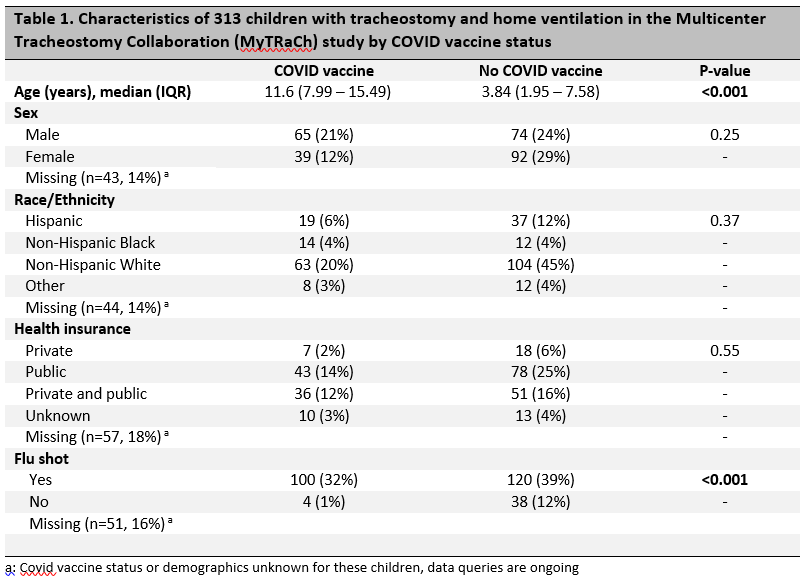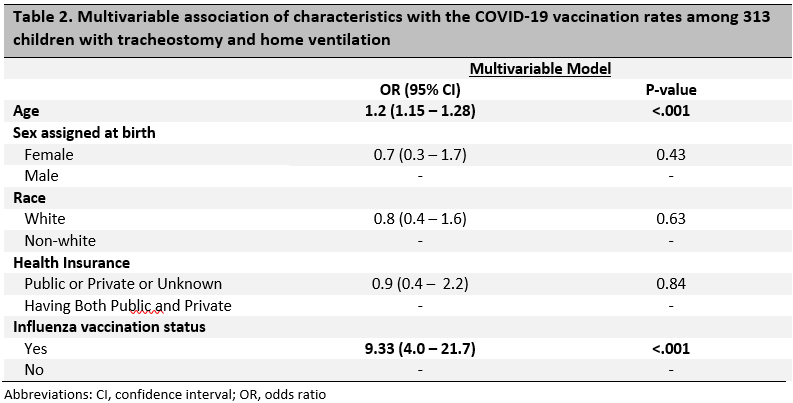Children with Chronic Conditions
Session: Children with Chronic Conditions 2
276 - Influenza and COVID-19 Vaccination Rates in a Prospective Multicenter Tracheostomy and Home Ventilation Cohort
Friday, May 3, 2024
5:15 PM - 7:15 PM ET
Poster Number: 276
Publication Number: 276.523
Publication Number: 276.523

Luis F. Enriquez, MD (he/him/his)
Clinical Research Specialist
Boston Children's Hospital
Jamaica Plain, Massachusetts, United States
Presenting Author(s)
Background: The Centers for Disease Control and Prevention (CDC) and the American Academy of Pediatrics (AAP) recommend annual influenza and COVID-19 vaccinations for all children aged 6 months and older unless medically contraindicated. Children with tracheostomy and home ventilation (HV) are at high risk for severe acute respiratory infections (ARIs), yet their vaccination rates are unknown.
Objective: To assess the vaccination status among children in a tracheostomy and home ventilation cohort.
Design/Methods: From 2022 to 2023, the 13-center Multicenter Tracheostomy Collaboration (MyTRaCh) study enrolled children on HV into a prospective cohort study examining ARIs. Throughout the study duration, site teams performed structured chart reviews and conducted quarterly interviews with parents, concurrently collecting longitudinal tracheal aspirates for a maximum of 20 months. We conducted descriptive statistics and multivariable logistic regression to analyze the association between demographic characteristics and the child’s influenza and COVID-19 vaccination status.
Results: Among 313 participants, the median age was 6.2 years (IQR 2.79 – 12.47), 58% were male, 61% identified as non-Hispanic White, and the median age at which tracheal placement occurred was 5 months (IQR 2.4 months – 1.2 years). Parents confirmed that 93% of their children’s immunizations were up to date. In their lifetime, 84% of the cohort received ≥1 influenza vaccine and 78% adhered to an annual influenza vaccine regimen. However, only 39% received the COVID-19 vaccine, and merely 16% had obtained a COVID-19 booster. Among children who had an influenza vaccine, 45% also had a COVID-19 vaccine. However, among those who did not have an influenza vaccine, 90% also did not have a COVID-19 vaccine (Table 1). After controlling for 5 factors and clustering by site, those significantly more likely to have a COVID-19 vaccine were older (OR 1.21, 95% CI 1.15 - 1.28) and had a previous influenza vaccine (OR 9.3, 95% CI 4.0 - 21.7) (Table 2).
Conclusion(s): In a prospective, multicenter cohort study of patients with tracheostomy and HV who are at high risk for life-threatening ARIs, most children received an annual influenza vaccine, but less than half had received a COVID-19 vaccine and even fewer had a COVID-19 booster. Those who had the influenza vaccine were more likely to have a COVID-19 vaccine. However, these low COVID-19 vaccine rates underscore the need for qualitative studies to identify the difference in acceptance of influenza and COVID-19 vaccines and develop interventions to increase COVID-19 vaccination acceptance in this population.


